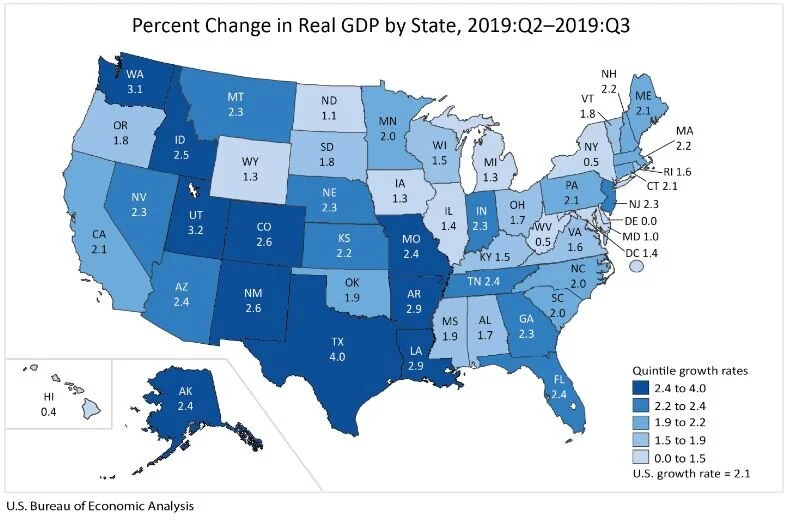Resurgence!
/The Washington Post ran an opinion piece on March 10, 2020, with the headline, “Why the Midwest is seeing a resurgence.” It was written by Mitch Daniels, the former governor of Indiana and currently the president of Purdue University.
Daniels’ column illustrates two principles of epistemology. First, narrative is not truth. Sometimes things sound right that aren’t. And second, facts often cannot be generalized.
You may have heard, “You can prove anything with statistics.” Or you may have heard quantitative evidence deprecated as “Lies, damn lies, and statistics.” But readers who are smart enough and sophisticated enough should always be able to sort the truth out of the bluster.
I do not contend that Daniels wrote any lies in his column. Every data point he mentions (with one exception) is correct. I know this because I looked them up. But things can be true without providing justification for conclusions that seem to flow directly from them. That is certainly true with Daniels’ piece.
He claims that the midwestern region of the US is “resurgent” — a word that implies it was down but now is back up to some level of success. Let’s dig into it. Daniels points to population changes as proof that the midwest thrives while the east and west coasts wane.
[T]he hemorrhage of people out of the Northeast and California is now unmistakable, and it’s less and less masked by international immigration. Net domestic migration from the Northeast now runs more than 350,000 per year; California is losing population, and likely a congressional district, for the first time in its history.
He's right about California losing a congressional seat. He doesn’t mention that Michigan, Illinois, Ohio and possibly Minnesota (all midwestern states) are also expected to lose congressional seats. If losing a seat in Congress is an indication of California’s waning fortunes, what does it say about other states that are also losing seats?
I don’t think Daniels is correct that California is losing population. Annual population estimates from the US Census Bureau show California’s population growing from 37.3 million in 2010 to 39.5 million in 2019. Adding 2.2 million is not “losing population.” California is growing slower (5.9% over 10 years) than the whole of the country (6.1% over 10 years), and much slower than Texas (14.9%), Florida (14.0%) and Arizona (13.6%).
In comparison, the Great Lakes states are hardly resurgent. Only Minnesota (6.2%) has grown as fast as the national average, while four others in the region (Indiana, Wisconsin, Ohio and Michigan) grew slower than the rest of the country and Illinois’ population fell by 150-thousand or 1.3%.
But let us note Daniels’ exact words: “losing population.” These words can be spun another way. If any people at all are moving away from California to live elsewhere, California can be said to be “losing” them. Even if California’s state population continues to grow (as it does), it losing the ones that moved away. To use the term “losing population” about a state with a growing population is not lying, and it is certainly not a reason to distrust the source data. It is merely spin. Daniels found a way to say what he wanted to say, and a data point that seemed to support his claim.
Later in the piece, Daniels points to cheap housing, low cost of living and short commutes as proof that the midwest is winning. But in a capitalist economy, things are cheap because the market doesn’t value them more highly. Housing is cheap in Indiana because people with money don’t want to live there, and because the people who live there can’t afford to pay more. That is hardly proof of resurgence.
Daniels pointed to a recent CNBC ranking of states as his evidence of midwestern resurgence. Rankings can be highly suspicious unless we know the criteria used. Rankings should not be taken as the final word, but they are interesting. The CNBC rankings are worth considering. Here’s Daniels:
Places such as Wisconsin, Michigan, Ohio and my home state of Indiana have built some of the country’s most business-friendly climates. Many have reformed and strengthened public education and seen positive results. Five of CNBC’s top 10 states for infrastructure are Midwestern, led by Indiana at No. 1.
From that, what state would you suppose is the #1 most business-friendly? Do you think it’s probably in the midwest? (No. It’s Virginia.) Daniels says midwestern states have built “some of” the most business friendly climates, but if they were at the top he’d have said, “THE” most business friendly climates. When he says “some of,” all you know for sure is that midwestern states are among the top 50.
In fact, according to the very source Daniels mentions, the Great Lakes states rank like this: Minnesota (#7); Ohio (#10); Indiana (#11); Wisconsin (#15); Michigan (#24); and Illinois (#30). So that’s none of the top five, two of the top 10, three of the top 20, and five of the top half of states.
Having “reformed and strengthened public education,” the resurgent states rank like this: Minnesota (#3); Wisconsin (#5); Ohio (#11); Indiana (#32); Illinois (#33); and Michigan (#43).
Daniels mentions Indiana’s rank of #1 in infrastructure. I had to look deeper into the CNBC report to learn what that means. They graded the states on several indicators, including air travel. And Indianapolis has an excellent, hassle-free, underused airport. Another criterion was access to markets. Indiana is ideal for warehousing because it is within 10 hours or so of all the nation’s population except the west coast. They also assessed quality of roads and bridges throughout each state, and Indiana’s roads are not as run-down and substandard as those in a lot of other states. According to the American Society of Civil Engineers, only 7.4% of Indiana’s bridges are structurally deficient, compared to 19.8% of bridges in Pennsylvania.
Let’s look at one more criterion. Daniels invited comparison of economic activity. He says,
“Studies now detail the resurgence of a host of Midwestern cities such as Kansas City, Mo., and Minneapolis, including some in what has been called the Rust Belt, such as Columbus, Ohio, and Madison, Wis. In recent years, gross domestic product in the Great Lakes states has been outgrowing that of the East Coast.”
Notice that Daniels pinpoints growth and resurgence in particular cities within states – not in Ohio, but in Columbus. Where do you suppose the people who are moving to Columbus are coming from. Daniels would have you believe they are moving from California or from New Jersey. And, no doubt, a few are. But the greater share of them are immigrants from foreign countries and people from smaller cities and rural areas of Ohio. The resurgence Daniels touts is just the depopulation of the rural and small-town parts of those midwestern states. Most of Indiana’s 92 counties are projected to lose population from now through the year 2050. And no change is expected after 2050 — that’s just as far out as the state demographer has projected.
The official and authoritative source for information about economic activity (measured in gross domestic product, which is, generally speaking, the sum of all buying, processing and selling that happens in the state) is the US Bureau of Economic Analysis, a branch of the US Department of Commerce. The BEA shows Illinois’ economic output grew over five years (2014 to 2018) by 4.78%. That’s the slowest growth among Great Lakes states. Indiana’s GDP grew from $313 billion to $329 billion, which is 5.23%. Ohio’s growth was 6.19%; Wisconsin’s 7.12%, Minnesota’s 8.39% and Michigan’s 9.32%. That sound like evidence of resurgence — until you learn that California’s GDP growth over that same interval of time was 19.08%. California grew twice as fast as Michigan, and nearly four times as fast as Illinois. Daniels assures us that the midwest is outstripping the east coast, and indeed, New Jersey’s growth was only 5.77% — less than four of the six Great Lakes states. But even that is growth.
This should be sufficient to show that even when someone gives you a fact, you can’t assume too much. Even if the fact is true, it is only one detail in complex web of details. Even when the fact is true, you can’t infer that other seemingly related things are also true. And you cant generalize. Indiana’s #1 ranking for infrastructure doesn‘t mean there are no potholes on Indiana roads.
You might say that Daniels just sees the midwest’s glass as half full, while I say it is half empty. But that is not the case at all. What I’m really trying to say is that a bigger glass holds more than a smaller glass. The half-empty glass could still hold plenty, if it is big enough. If a glass is too small, it can’t hold enough even if it is full. Until you know the size of the glasses and how they are being measured, you can’t make reasonable comparisons.
Daniels has engaged here is some selective uses of data. He has certainly been deceitful, though nothing he says is factually wrong. He using ordinary levels of narrative spin. Much of the information that a citizen gets today is at least as deceptive as this piece by Daniels. It is the duty iof the citizen to learn how to parse the truth.
I am an Indiana resident and an employee of Purdue University.









